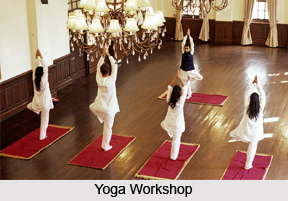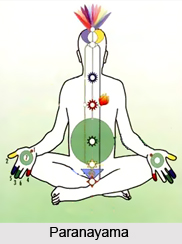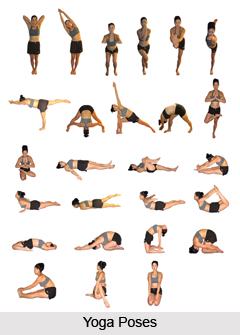 The role of yoga asanas in daily life cannot be overlooked since the changes in the practitioner`s lifestyle in clearly seen. As the body is nurtured and conditioned through regular, nonabrasive movement called asanas, the yogis believe that these exercises expand mental faculties and develop spiritual capacity as well.
The role of yoga asanas in daily life cannot be overlooked since the changes in the practitioner`s lifestyle in clearly seen. As the body is nurtured and conditioned through regular, nonabrasive movement called asanas, the yogis believe that these exercises expand mental faculties and develop spiritual capacity as well.
Yoga Asanas are based on certain principles and the Yogis conceived the Asanas (mentioned in their works) in accordance with these principles after carefully observing the mechanism, nature and quality of living organisms. They believe that as these organisms (i.e. the body) are changeable; on account of their being products of the three Gunas, the external forms of the Asanas are accountable to be changed in harmony with bodily changes that occur from the change in time, place and so on.
One of the most integral principles in yoga asanas is that Kama (ignorance), Krodha (anger), Bhaya (fear), Nidra (sleep) and Svasa (breathing) are the faults, which reside in the body and should be abolished in order to attain true salvation through the yoga asanas or yoga poses. However, with passage of time it is seen that regular and proper practice of Asana can help to curb these vices to a considerable degree. Further, if the practice of Asana is combined with the practice of Pranayama, then the power to curtail or check these feelings become extremely developed. The practice of Asana enables a person to ponder peacefully and deeply over the delicate aspects of spiritual doctrines, for he is undisturbed by bodily flaws or external conditions. Thus, the practice of Asana acts as a helping factor for Manas (ratiocination). Gradually the practice of Asana (accompanied by the practice of Pranayama and Pratyahara) renders the body a worthy seat of spiritual experience.
The physiology of ordinary, freehand exercises cannot be applied to the Yoga Asanas. The ordinary exercises often lead to only physical development, but the complete procedure of asanas brings about a mental growth of the individual and works on the overall purification of mind and body. Yoga Asanas react on human body both externally and internally. In spiritual sense, asanas are effective for those who are interested in the spiritual path. Asanas prove to be stepping stones in the quest for liberation or self-realisation. While in the mental sphere, the asanas make the mind strong and able to endure pain and unhappiness. Determination, concentration and memory are also enhanced. Physically, yoga asanas tone the Muscles, Bones, Nervous System, Respiratory, Circulatory and Digestive Systems. All the systems of human body are co-related with each other. The body becomes more flexible, and more capable to adjust to environmental changes. The sympathetic and para-sympathetic nervous systems of human body are brought into a state of balance by practicing yoga asanas regularly.

It is indeed a remarkable way of training which strives to perfect not only the muscles and the loco-motor system but also the entire human organism including man`s mind, his nervous system and the delicate inner organs and systems such as heart, vascular vessels, lungs, stomach, intestines, liver, kidneys, internal secretion glands, through mere physical postures. Yoga asanas mainly lubricate the joints, muscles, tendons and ligaments; improve circulation and the activity of the nervous system, increase flexibility of the body and release tension.
Yoga Asanas manipulate the endocrine glands and the supply of blood can be regulated to any particular part of the body without much strain or loss of muscular energy. Also by increasing the intra-capillary pressure, as seen in certain Yogic postures, the flow of lymph is considerably supported, resulting in better tone and growth of the tissue elements. The cumulative effect of cellular health affects all organs including the endocrine glands, and is also reflected on the mental perspective on the character, behaviour and personality of the student. It is this mental transformation from the lower to the higher strata, which Yoga actually seeks to promote, in some aspects, through special physical education or `asanas`. Prolonged, deep, and rhythmic breathing, associated with each movement also multiplies the efficiency of the respiratory system. Further, because of the increased supply of oxygen in the blood during Yoga exercises, all the other systems of the body obtain the extra advantage of richer blood supply. The people who follow Yoga regularly, the vasomotor adjustments reduce the danger of fatigue to the minimum.
Laboratory evidence has proved that if plenty of oxygen-rich blood is steadily pumped out to the muscles and the internal organs of the human body, they will not exhaust because the speed of metabolism is ideally coordinated. Yoga Asanas done systematically help to maintain the normal rate of metabolism even while exercising. Moreover, the effect of Yoga physical education has incredible effects on the digestive system and has been proved to be more beneficial than any strenuous exercise because it does not deprive that system of the normal supply of blood, which otherwise gets abstracted to the muscles during muscular exertion. This effect is because of the static condition of the skeletal muscles, deep and forceful movements of the diaphragm, favourable changes in the respiratory actions, mechanical intra-abdominal compression, and additional gravity-pressure. During Yoga practice, all the digestive organs receive an increased supply of blood, which is richer in quality, owing to the increased respiratory activity. Maintaining some particular types of the yoga asanas encourages strength and endurance. Weight bearing asanas may help prevent osteoporosis, and may also help those already diagnosed with osteoporosis, if practiced with care, under the supervision of a qualified Yoga teacher. Long-term benefits of yoga asanas include reduced back pain and improved posture.
 Yoga Asanas benefit the abdominal muscles as well. The viscera have the tendency to descend and thus damage the function of the vessels that reach through the mesentry by impeding the circulation of blood in the pelvic area. While practicing Yoga asanas, the abdominal muscles are held in position against the pull of gravity by the floor of the pelvis, by tightening the muscles of the lower torso and the delicate bands of mesentry on the pelvic floor. Stretching requires very little time and effort and thus widens the range of motion. Yoga stretching coupled with a few deep full breaths, is extremely beneficial to remove mental tension and helps in completing de-stressing reflexes.
Yoga Asanas benefit the abdominal muscles as well. The viscera have the tendency to descend and thus damage the function of the vessels that reach through the mesentry by impeding the circulation of blood in the pelvic area. While practicing Yoga asanas, the abdominal muscles are held in position against the pull of gravity by the floor of the pelvis, by tightening the muscles of the lower torso and the delicate bands of mesentry on the pelvic floor. Stretching requires very little time and effort and thus widens the range of motion. Yoga stretching coupled with a few deep full breaths, is extremely beneficial to remove mental tension and helps in completing de-stressing reflexes.
Yoga Asanas are isometric, which means they depend on holding muscle tension for a short period of time. This improves cardiovascular fitness and circulation. Studies show that regular yoga practice may help to normalise blood pressure. In the posture of stomach lift, it raises the diaphragm, which massages the heart from below. This strengthens the heart muscle, resulting in better circulation and less chance of heart disease. The stomach lift also massages the digestive organs, as well as contracting and stretching them. Yoga Asanas contribute to healthy skin as well. Stretching of the skin during the asanas or yoga poses causes stimulation of the skin cells and results in firmer, healthier skin that usually do not loosen down or wrinkle.
Any constant lack of motion in the joints leads to their maladjustment and even general deterioration. Older people who regularly practise Yoga is seen to preserve their flexibility and hence the spinal column is in a healthy condition which in turn assures good functioning of internal organs and maintenance of optimum efficiency. Well-built muscles are necessary since they form on an average about 43% of one`s weight, but the development of the muscles should not be at the cost of other important systems of the body. The ideal form of physical education should be simple in its technique, self-sufficient, easy to practise; nonviolent, requiring little time and no great effort so that on the average both the young and the old may follow it without any misapprehension and at the same time gain the maximum physical and mental benefit with the minimum of effect.
Yoga poses greatly improve the human nervous system. Improved blood circulation, easing of muscle tension and the act of focusing the mind on the breath all combine to pacify the nervous system. Long-term benefits include reduced anxiety levels and stress, and increased feelings of calm and well-being. Nerves from the brain and spine connect every tissue in the body and therefore the health of every tissue in the body depends upon the health of the brain and spine. While practicing asanas, the headstand causes an increase in circulation to the brain, which stimulates the nerve cells of the brain, thus resulting in increased vitality and improved brain function (intelligence and memory).
The nerves from the spine go to all the organs and glands of the body and a healthy spine plays an important role in vitality and rejuvenation. In fact, the spine is more critical for the well-being of the mass than the brain, since the brain is well protected by the cranium or skull bone. The spinal nerves do not have protection against mechanical insults as the brain does. Thus keeping these nerves active is very important.
 The ancient yogis fully understood the vulnerability of the spine and the propensity for slight spinal misalignments to occur and thus promoted asanas to keep the spine flexible, so that there would be much less chance of spinal misalignments. Some of the yoga asanas can even correct some minor spinal misalignments.
The ancient yogis fully understood the vulnerability of the spine and the propensity for slight spinal misalignments to occur and thus promoted asanas to keep the spine flexible, so that there would be much less chance of spinal misalignments. Some of the yoga asanas can even correct some minor spinal misalignments.
If a person does nothing to improve the spine`s flexibility, as he/she gets older, the condition of the spine will deteriorate further and the spinal nerves will be increasingly impinged upon. This will lead to further deterioration of organs and glands, until eventually they become diseased. Asanas train the body in a way that leads one to control over voluntary muscles and then control over the involuntary and the more difficult ones. Awareness derived through asanas, is consciousness together with realisation of what is happening within or without. Thus, the state of awareness can be reached only through control of the voluntary and subsequently the involuntary muscles.
There are certain recommendations designed to enhance the results of asanas in daily life. They are as follows -
•It is advised to stay hydrated throughout the day and have at least eight ounces of water before the practice of asanas.
•It is best to perform yoga asanas in an empty stomach, usually in the morning or three hours after the last meal. If the person needs energy, he can have a piece of fruit one hour prior to exercising.
•Inhaling and exhaling through the nose is always preferable.
•To aid in concentration, it is better to exercise in a calm, warm environment.

•Although there is a difference of opinion on this issue, it is commonly suggested that women should avoid doing inverted poses during menstruation. Other yoga asanas can be easily practiced during this time. However, pregnant women should definitely avoid inverted poses and certain stomach poses after the first three months of pregnancy.
The primary building blocks of yoga are the asanas and the movement of breath. A series of poses held over a period of time and synchronised with the breath exercises every part of the body and thus over the years, yoga asanas have proved its utility in the daily life of the mass.
The `Yogi` in the real sense works on the basis of higher concepts. Surprisingly modern scientific advances in biology, physiology and anatomy have reached a level where, analytical researches are done to reach objectives through asanas. However, the theory or practical data that has been given by the ancient Yogis are massive and the modern scientists have probably not reached that corner of ultimate knowledge. The ancient Yogins should have probed beyond anatomy and physiology to seek knowledge and truth that enlightened them both mentally and physically. Moreover, it was no idle curiosity that inspired them to deeper researches, but the very objective of their life, which could be described as the thirst of ultimate realisation. Yoga Asanas to the ancient Yogis were like mysteries of the higher and subtler planes of existence. The textual data of the ancient Yogis that are still available state that they were well acquainted with the various categories of organic energy such as muscle-energy, nerve-energy, animal electricity and the aggregate known as the life-force (bioenergy or Prana). What is especially noteworthy, however, is the fact that the Yoga authorities have articulated this energy as the primordial in biology and the ultimate in matter. Anatomy and physiology are mere evolutes of the primal energy (Prakriti).




















